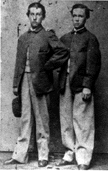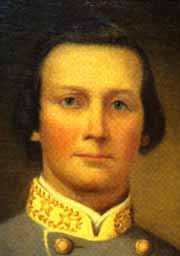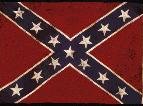South Carolina
C.S.A.


South Carolina
C.S.A.
|
South Carolina C.S.A.
|

|
|

|
South Carolina C.S.A. |
|
Late of the Sixteenth South Carolina Pictured here with friend George Weber From the collection of David Rudge and Family |
|
All of the information used here was researched and shared by David Rudge, Assistant Professor, Western Michigan University. I remain the editor and sometime writer, so if there are errors, I am sure they are mine. As all of you know, this page is made possible by the information you contribute. To thank David, Click Here: E-Mail Descendant If ever there was a boy's war, it was the War Between the States; the south in particular, buried most of three generations in an attempt to be free and self-governing. These stories, the stories of the sacrifices made by children, are particularly compelling today. We think our children cannot care for self at twenty, yet so many of these children became men by twelve. The was a time of high adventure, a time when any boy could become a king. This was not a distant thought to southern boys, they knew well of Sam Houston. Many of their brothers had fought in strange places south of the border while trying to filibuster their way to becoming a president or a king. They knew of revolutions led in Nicaragua and closer to home, the fight for the south in Missouri and bloody Kansas, a place where mad men like John Brown killed their brothers. No less a person than Christopher Memminger, Secretary of the Treasury of the Confederate States of America, had once been no more than an orphan on the streets of Charleston. It was a time of destiny, when only his ability, his luck, and the size of his dreams limited a boy. No danger here for me, thought so many... only a chance to carry the flag or become a pirate, or maybe capture a sultan or two. For the southern boy it was and still is viewed as a time of opportunity to dispose of the tyrant that would suppress the will of a people. In the Sixteenth, I have found no child’s story that is more compelling than the adventure that was the life of Private John William Rudge. Private Rudge was born on February 12, 1849, in Le Havre, France. His father and mother immigrated to America in the late eighteen fifties, bringing both John and his sister. In 1860, following the death of the father, the family located in Columbia, South Carolina. In January of 1863, at the age 13, a fatherless child, John Rudge found his way to the coast of South Carolina and enlisted in the Sixteenth as a musician and drummer. Serving first in Company K and later with the Field and Staff, one wonders if he came under the watchful eye of Samuel Stradley, also an English expatriate, serving on the Field and Staff of the unit. What we do know is this, at some point in late 1863 or early 1864, just prior to the killing time for the Sixteenth, John, at that point at fourteenth year old drummer boy left the unit. The only notation being on one of the last muster roles, probably signed by Stradley, is the notation, "Gone to Bermuda." A unique notation that could mean much or nothing, but a notation that indicates it would probably be futile to hunt for the boy. We will probably never know the how or the why of this, but one is forced to wonder if some divine providence didn't work to separate the young man from what was most certainly to be a time when the unit was to be tested by fire. As is often the case with the hand of God, it moves through man, and one must wonder who the man was that helped the boy with his decision. One is also forced to speculate on his status as an orphaned child of a widow, and seek some sort of answer in the ways of those who are inclined to be compassionate toward the children who hold that status, all of which is nothing more than speculation. What we do know is that John William Rudge, a lost boy in a strange land, felt himself compelled to remove to what appeared to be a safe haven, or a better adventure, the why forever lost in the mist of time. What seems to have happened is that in what must have been an amazing journey, John William Rudge found his way south to Bermuda. How did he run the blockade out and with what ship, from what port? This being only one of many questions. Once in Bermuda, John embarked on an equally dangerous, if certainly more rewarding career, that of the cabin boy on a blockade-runner. It was from here that his daughter tells us he was captured and brought to Havana and then to New York City, where Lee's surrender found him. Following the war, John William returned to Wilmington, N.C., the blockader's paradise, and there began life again. He married Carrie V. Pea (Pae) in October of 1870. John was by trade a tinner and he carried his craft wherever he found himself but as we shall see he became so much more. Relocating to Monroe, North Carolina, his wife practiced her craft as a milliner and John William continued to work in tin. Like so many other Confederates he became a Mason in Monroe. In the 1880, following reconstruction, he affiliated with the local militia, the Monroe Light Infantry. Moving between Monroe and Savannah, Georgia, John continued to work to build his business. As always he made good use of what must have been an excellent mind. Around the turn of the century, John developed and patented a planter that combined two of the most important steps in planting cotton. This was a substantial improvement in process that reduced the labor of the farmer, in an era begging for bright and useful mechanical answers. In order to capitalize on the invention, John William and his son, William John, had by 1905, embarked on the manufacture and production of his planter in Monroe, N.C. The company continued in production at least until 1910, feeding what was an ever-growing market in a fast changing south. In 1913, John William Rudge was struck with illness and forced to spend the rest of his life hospitalized, dying two years later, thus ending one of the most remarkable journeys of any man who served with the Sixteenth. John Rudge: sailor, traveler, blockade-runner, soldier, tinsmith, inventor, manufacturer, businessman, prisoner, fighter for liberty, father, husband, and drummer boy, his exodus ended, he retired from the craft. He was buried with Masonic Ceremony and joined by Carrie in 1922. Together they left five children, Bettie L. Rudge, Caroline Virginia Rudge, William John Rudge, Kate Irma Rudge, and Archie Clifton Rudge, a host of unanswered questions, and a legacy that reaches to the present. |
|
Born: February 17, 1849, Le Havre, Seine Maritime, France Died: December 3, 1915, Morganton, Burke County, North Carolina Buried: Monroe City Suncrest Cemetery, Monroe, Union County, North Carolina Son of John Rudge and Louise Mitchele For More Information and photos Note that you will leave this site, please bookmark for later return. SMB Information developed by David Rudge, our thanks to him for this most wonderful piece of history, story written by SMB |

|
|
|

|